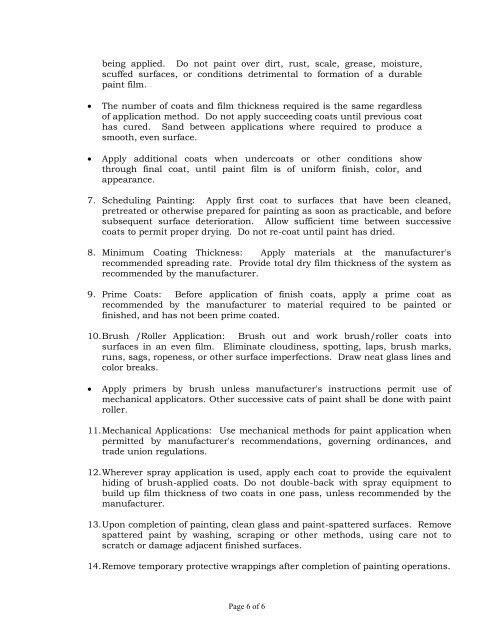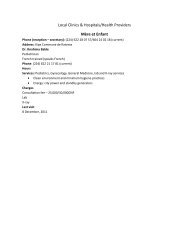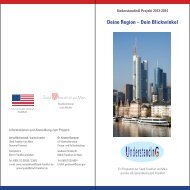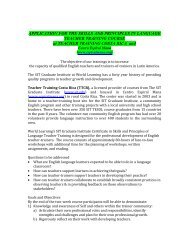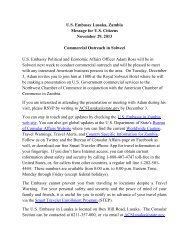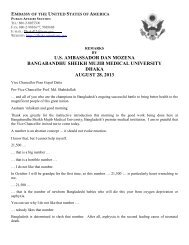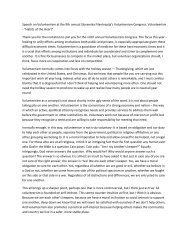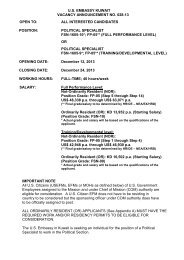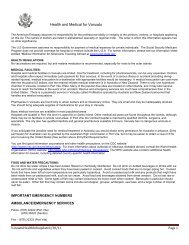Exterior painting of Enclave compound building, American Embassy
Exterior painting of Enclave compound building, American Embassy
Exterior painting of Enclave compound building, American Embassy
You also want an ePaper? Increase the reach of your titles
YUMPU automatically turns print PDFs into web optimized ePapers that Google loves.
eing applied. Do not paint over dirt, rust, scale, grease, moisture,<br />
scuffed surfaces, or conditions detrimental to formation <strong>of</strong> a durable<br />
paint film.<br />
<br />
<br />
The number <strong>of</strong> coats and film thickness required is the same regardless<br />
<strong>of</strong> application method. Do not apply succeeding coats until previous coat<br />
has cured. Sand between applications where required to produce a<br />
smooth, even surface.<br />
Apply additional coats when undercoats or other conditions show<br />
through final coat, until paint film is <strong>of</strong> uniform finish, color, and<br />
appearance.<br />
7. Scheduling Painting: Apply first coat to surfaces that have been cleaned,<br />
pretreated or otherwise prepared for <strong>painting</strong> as soon as practicable, and before<br />
subsequent surface deterioration. Allow sufficient time between successive<br />
coats to permit proper drying. Do not re-coat until paint has dried.<br />
8. Minimum Coating Thickness: Apply materials at the manufacturer's<br />
recommended spreading rate. Provide total dry film thickness <strong>of</strong> the system as<br />
recommended by the manufacturer.<br />
9. Prime Coats: Before application <strong>of</strong> finish coats, apply a prime coat as<br />
recommended by the manufacturer to material required to be painted or<br />
finished, and has not been prime coated.<br />
10. Brush /Roller Application: Brush out and work brush/roller coats into<br />
surfaces in an even film. Eliminate cloudiness, spotting, laps, brush marks,<br />
runs, sags, ropeness, or other surface imperfections. Draw neat glass lines and<br />
color breaks.<br />
<br />
Apply primers by brush unless manufacturer's instructions permit use <strong>of</strong><br />
mechanical applicators. Other successive cats <strong>of</strong> paint shall be done with paint<br />
roller.<br />
11. Mechanical Applications: Use mechanical methods for paint application when<br />
permitted by manufacturer's recommendations, governing ordinances, and<br />
trade union regulations.<br />
12. Wherever spray application is used, apply each coat to provide the equivalent<br />
hiding <strong>of</strong> brush-applied coats. Do not double-back with spray equipment to<br />
build up film thickness <strong>of</strong> two coats in one pass, unless recommended by the<br />
manufacturer.<br />
13. Upon completion <strong>of</strong> <strong>painting</strong>, clean glass and paint-spattered surfaces. Remove<br />
spattered paint by washing, scraping or other methods, using care not to<br />
scratch or damage adjacent finished surfaces.<br />
14. Remove temporary protective wrappings after completion <strong>of</strong> <strong>painting</strong> operations.<br />
Page 6 <strong>of</strong> 6


